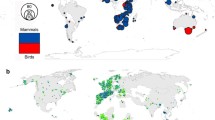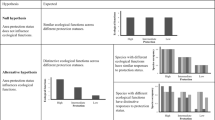Abstract
Growing deterministic and stochastic threats to many wild populations of large vertebrates have focused attention on the conservation significance of captive breeding and subsequent reintroduction. However, work on both gorillas and black rhinos questions this shift in emphasis. In these species, field-based conservation can be effective if properly supported and, although this is not cheap, per capita costs may still be considerably lower than for ex situ propagation in captivity. Here we attempt to broaden the scope of this debate by contrasting the breeding success and costs of in situ and captive programmes for a range of threatened mammals. Data are scarce, but we find that across nine large-bodied genera, in situ conservation achieves comparable rates of population growth to those seen in established captive breeding programmes. Moreover, comparing budgets of well-protected reserves with zoos' own estimates of maintenance costs and the costs of zoo adoption schemes, we find that per capita costs for effective in situ conservation are consistently lower than those of maintenance in captivity. Captive breeding may be more cost-effective for smaller-bodied taxa, and will often remain desirable for large mammals restricted to one or two vulnerable wild populations. However, our results, coupled with the fact that effective in situ conservation protects intact ecosystems rather than single species, lead us to suggest that zoos might maximize their contribution to large mammal conservation by investing where possible in well-managed field-based initiatives, rather than establishing additional ex situ breeding programmes.
Similar content being viewed by others
References
Allendorf F.W. (1993) Delay of adaptation to captive breeding by equalizing family size. Conserv. Biol. 7, 416–9.
Anon (1986) The 1986 rhino census for Chitwan National Park, Smithsonian-Nepal Teral Ecology Project Newsletter 4, 3–5.
Anon (1988) Brow-antlered deer in captivity. Oryx 22, 233.
Aveling C. and Aveling R. (1989) Gorilla conservation in Zaire. Oryx 23, 64–70.
Balmford, A., Mace, G.M. and Leader-Williams, N. (in press) Designing the ark:setting priorities for captive breeding. Conserv. Biol.
Beck B.B. Rapaport L.G., Stanley Price M.R. and Wilson A.C. (1994) Reintroduction of captive-born animals. In Creative conservation: interactive management of wild and captive animals (P.J.S.Olney, G.M.Mace and A.T.C.Feistner, eds) pp. 265–86. London: Chapman & Hall.
deBoer L.E.M., Brouwer K. and Smits S. (eds) (1993) EEP Yearbook 1992/93 including the Proceedings of the 10th EEP Conference, Salzburg 28–30 June 1993. Amsterdam: EAZA/EEP Exccutive Office.
Campbell S. (1980) Is reintroduction a realistic goal? In Conservation biology. An evolutionary-ecological perspective (M.E.Soulé and B.A.Wilcox, eds) pp. 263–69. Sunderland, MA: Sinauer Associates.
CBSG (1992) Ark into the 21st century. A global conservation strategy for zoos and aquaria. Apple Valley, MN: Captive Breeding Specialist Group.
Choudhury A. (1987) Railway threat to Kaziranga. Oryx 21, 160–3.
Chowdhury M.K. and Sanyal P. (1985) Use of electroconvulsive shocks to control tiger predation on human beings in Sunderbans Tiger Reserve. Tigerpaper 12, 1–5.
Conway W.G. (1980) An overview of captive propagation. In Conservation biology. An evolutionary-ecological perspective (M.E.Soulé and B.A.Wilcox, eds) pp. 199–208. Sunderland, MA: Sinauer Associates.
Conway W.G. (1986) The practical difficulties and financial implications of endangered species breeding programmes. Int. Zoo Yb. 24/25, 210–9.
Conway, W.G. (1992) The conservation park: a new zoo synthesis for a changed world. Paper presented at AAZPA Annual Conference, 17 September. Toronto.
Department of Wildlife Protection (1985) Ecological cum management plan for Dachigan National Park, Jammu and Kashmir State 1985–90. Srinagar: Department of Wildlife Protection.
Derrickson S.R. and Snyder N.F.R. (1992) Potentials and limits of captive breeding in parrot conservation. In New World parrots in crisis: solutions from conservation biology (S.R.Beissinger and N.F.R.Snyder, eds) pp. 133–63. Washington, DC: Smithsonian Institute Press.
Dobson A.P., Mace G.M., Poole J., and Brett R.A. (1991) Conservation biology: the ecology and genetics of endangered species. In Genes in ecology (R.J.Berry, T.J.Crawford and G.M.Hewitt, eds) pp. 405–30. Oxford: Blackwell.
Flesness N.R. and Foose T.J. (1990) The role of captive breeding in the conservation of species. In IUCN red list of threatened animals (IUCN, ed.) pp. xi-xv. Gland/Cambridge, IUCN.
Foose T.J. (1993) Global management of rhinos. In Rhinoceros biology and conservation (O.A.Ryder, ed.) pp. 32–47. San Diego: Zoological Society of San Diego.
Foose T.J. and Ballou J. (1988) Management of small populations. Int. Zoo Yb. 26, 26–41.
Frankel O.H. and Soulé M.E. (1981) Conservation and evolution. Cambridge: Cambridge University Press.
Gnam R.S. (1990) Conservation of the Bahama parrot. Amer. Birds 44, 32–6.
Gordon I.J. (1991) Ungulate re-introductions: the case of the scimitar-horned oryx. Symp. Zool. Soc. Lond. 62, 217–40.
Green, M.J.B. (1989) Reintroduction of sika to the Kenting National Park. Taiwan, Republic of China. Unpublished report to the Formosan Sika Deer Restoration Project.
Green M.J.B. (1990) Report on a preliminary visit to Manipur. WWF Project 4001.17/India. Gland: WWF.
Griffith B., Scott J.M., Carpenter J.W. and Reed C. (1989) Translocation as a species conservation tool; status and strategy. Science 245, 477–80.
Groombridge B. (ed.) (1993) 1994 IUCN red list of threatened animals. Gland/Cambridge: IUCN.
Harcourt A.H. (1986) Gorilla conservation: anatomy of a campaign. In Primates: the road to self-sustaining populations (K.Benirschke, ed.) pp. 31–46. New York: Springer-Verlag.
Harvey P.H. and Pagel M.D. (1991) The comparative method in evolutionary biology. Oxford: Oxford University Press.
ISIS (1989) User manual for SPARKS — the Single Population Analysis and Record Keeping System v. 2.11. Apple Valley, MN: ISIS.
IUCN (1987) The IUCN policy statement on captive breeding. Gland: IUCN.
IUDZG/CBSG (IUCN/SSC) (1993) The world zoo conservation strategy; the role of zoos and aquaria of the world in global conservation. Brookfield, IL: Chicago Zoological Society.
Jackson, R. and Ahlborn, G. (1986) Himalayan snow leopard project. Final progress report: Phase 1. California Institute of Environmental Studies.
Kleiman D.G., Beck B.B., Dietz J.M. and Dietz L.A. (1991) Costs of a reintroduction and criteria for success: accounting and accountability in the golden lion tamarin conservation program. Symp. Zool. Soc. Lond. 62, 125–42.
Leader-Williams N. (1990) Black rhinos and African elephants: lessons for conservation funding. Oryx 24, 23–9.
Leader-Williams N. (1993) Theory and pragmatism in the conservation of rhinos. In Rhinoceros biology and conservation (O.A.Ryder, ed.) pp. 69–81. San Diego: Zoological Society of San Diego.
Leader-Williams N. and Albon S.D. (1988) Allocation of resources for conservation. Nature 336, 533–5.
Lyles A.M. and May R.M. (1987) Problems in leaving the ark. Nature 326, 245–6.
Mace G.M. (1986) Genetic management of small populations. Int. Zoo Yb. 24/25, 167–74.
MacKinnon K. and MacKinnon J. (1991) Habitat protection and re-introduction programmes. Symp. Zool. Soc. Lond. 62, 173–98.
Martin R.B. (1993) Rhino population dynamics, illegal hunting and law enforcement in the Lower Zambezi Valley in Zimbabwe. In Rhinoceros biology and conservation (O.A.Ryder, ed.) pp. 10–31. San Diego: Zoological Society of San Diego.
May R.M. (1991) The role of ecological theory in planning re-introductions of endangered species. Symp. Zool. Soc. Lond. 62, 145–63.
Miller B. and Mullette K.J. (1985) Rehabilitation of an endangered Australian bird: the Lord Howe Island Woodhen Tricholimnas sylvestris (Sclater). Biol. Conserv. 34, 55–95.
Rahbek C. (1993) Captive breeding — a useful tool in the preservation of biodiversity? Biodiv. Conserv. 2, 426–37.
Ramono W.S., Santiapillai C. and MacKinnon K. (1993) Conservation and management of Javan rhino (Rhinoceros sondaicus) in Indonesia. In Rhinoceros biology and conservation (O.A.Ryder, ed.) pp. 265–73. San Diego: Zoological Society of San Diego.
Santiapillai C. and MacKinnon K. (1993) Conservation and management of Sumatran rhino (Dicerorhinus sumatrensis) in Indonesia. In Rhinoceros biology and conservation (O.A.Ryder, ed.) pp. 257–64. San Diego: Zoological Society of San Diego.
Savidge J.A. (1987) Extinction of an island forest avifauna by an introduced snake. Ecology 68, 660–8.
Seal U.S. (1986) Goals of captive propagation programmes for the conservation of endangered species. Int. Zoo Yb. 24/25, 174–9.
Seal U.S., Ballou J. and Padua C. (1990) Leontopithecus population viability analysis. Apple Valley, MN: Captive Breeding Specialist Group.
Smith, J.L.D., Mishra, H.R. and Jordan, P.A. (1983) Population level management: a step in developing a tiger conservation strategy. Paper presented at Bombay Natural History Society Centenary Seminar on Conservation in developing countries. Indian Institute of Technology, Powai, Bombay. 6–10th December 1983.
Smith K. and Smith F. (1993) Conserving rhinos in Garamba National Park. In Rhinoceros biology and conservation (O.A.Ryder, ed.) pp. 166–87. San Diego: Zoological Society of San Diego.
Soulé M.E. (ed.) (1987) Viable populations for conservation. Cambridge: Cambridge University Press.
Soulé M., Gilpin M., Conway W. and Foose T. (1986) The millenium ark: how long a voyage, how many staterooms, how many passengers? Zoo Biol. 5, 101–13.
Soulé M.E. and Simberloff D.S. (1986) What do genetics and ecology tell us about the design of nature reserves? Biol. Conserv. 35, 19–40.
Spalton A. (1993) A brief history of the reintroduction of the Arabian oryx Oryx leucoryx into Oman 1980–1992. Int. Zoo Yb. 32, 81–90.
Stanley Price M.R. (1989) Animal re-introductions: the Arabian oryx in Oman. Cambridge: Cambridge University Press.
Stanley Price M.R. (1993) What will it take to save the rhino? In Rhinoceros biology and conservation (O.A.Ryder, ed.) pp. 48–68. San Diego: Zoological Society of San Diego.
Stuart S.N. (1991) Re-introductions: to what extent are they needed? Symp. Zool. Soc. Lond. 62, 27–37.
Templeton A.R. (1986) Coadaptation and outbreeding depression. In Conservation biology. The science of scarcity and diversity (M.E.Soulé, ed.) pp. 105–16. Sunderland: Sinauer Associates.
Thorne E.T. and Oakleaf B. (1991) Species rescue for captive breeding: black-footed ferret as an example. Symp. Zool. Soc. Lond. 62, 241–61.
Tudge C. (1991) Last animals at the zoo. How mass extinction can be stopped. Oxford: Oxford University Press.
Wiese R.J., Willis K., Bowdoin J. and Hutchins M. (1993) AAZPA annual report on conservation and science 1992–1993. Bethesda, MD: American Association of Zoological Parks and Aquaria.
WRI/IUCN/UNEP (1992) Global biodiversity strategy. Baltimore/Gland: WRI/IUCN/UNEP.
Author information
Authors and Affiliations
Rights and permissions
About this article
Cite this article
Balmford, A., Leader-Williams, N. & Green, M.J.B. Parks or arks: where to conserve threatened mammals?. Biodiversity and Conservation 4, 595–607 (1995). https://doi.org/10.1007/BF00222516
Received:
Accepted:
Issue Date:
DOI: https://doi.org/10.1007/BF00222516




